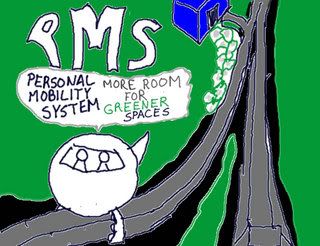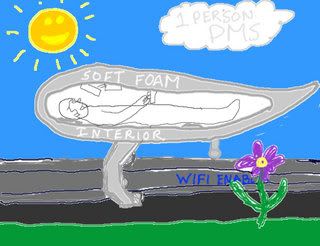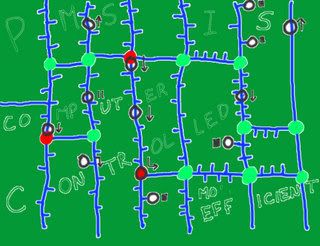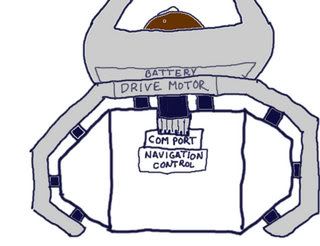The current road system has many problems. The major problem is cars and trucks drive on them. Cars and trucks are large and metal. Moving around large metal boxes with human drivers often on various substances leads to many deaths and large amounts of pollution. There is an answer though...

The Personal Mobility System would involve a small amount of infrastructure to become useful. It would definitely need to grow from a small community system, but would only require a single track in most areas.

If a single person is traveling, only the energy needed to transport
that one person will be used. A lightweight structure can grab onto a
rail or asphalt log in order to maintain stability and traction.

If every car in the system can be monitored and controlled by the track, a person can get from point A to point B simply and efficiently. A destination on the PMS system for the PMSpod must first be chosen. Then the pod routes its course automatically. The system is set up with nodes or intersections that will be notified of a PMSpod's need to pass through it. The node then matches all intersection crossings to a schedule where the time it takes for the PMSpod to safely pass through the intersection without collision is allocated to each pod. Furthermore, when a PMSpod is within a certain distance from the node, it notifies other pods in the area and elicits a response from the other PMSpods to ensure they are not approaching too quickly. If necessary, it adjusts the schedule at this point. If a node's schedule is too full, it notifies other nearby nodes and those nodes reply with their ability to reroute. If that fails, the node also has the ability to increase the speed of nearby traffic to allfow for more swift scheduling of traffic.

PMSpods are not just for travel. The system also has the potential to be a supplier of internet access both in the pods and out. Nodes could also store wifi routers accessible by both the PMSpods and local citizens. The pods will run with highly efficient electric motors with a battery or capacitor storing charge for each voyage. since the load is much lighter, much smaller motors are needed than those of an electric car. In addition, the PMSpods could be charged by the logs they travel on. Metering energy expenditure for billing would not be difficult.
Inside the PMSpod is a cozy interior that can range from a bedlike setting where the person can lie down and watch TV or use a computer and webcam connected to the internet to mass seating for cheap public transportation on the PMS system
PMSlogs also allow for plenty of room for utility lines, which in a log would allow for greater accessibility in servicing. Each node can be removed and replaced and the removed PMSnode can be transported by PMS to a servicing station and then used at another node juncture. The same applies for the connections between nodes which can be modular, each one spanning several meters, but small enough for easy transport to servicing and replacement.

The Personal Mobility System would involve a small amount of infrastructure to become useful. It would definitely need to grow from a small community system, but would only require a single track in most areas.

If a single person is traveling, only the energy needed to transport
that one person will be used. A lightweight structure can grab onto a
rail or asphalt log in order to maintain stability and traction.

If every car in the system can be monitored and controlled by the track, a person can get from point A to point B simply and efficiently. A destination on the PMS system for the PMSpod must first be chosen. Then the pod routes its course automatically. The system is set up with nodes or intersections that will be notified of a PMSpod's need to pass through it. The node then matches all intersection crossings to a schedule where the time it takes for the PMSpod to safely pass through the intersection without collision is allocated to each pod. Furthermore, when a PMSpod is within a certain distance from the node, it notifies other pods in the area and elicits a response from the other PMSpods to ensure they are not approaching too quickly. If necessary, it adjusts the schedule at this point. If a node's schedule is too full, it notifies other nearby nodes and those nodes reply with their ability to reroute. If that fails, the node also has the ability to increase the speed of nearby traffic to allfow for more swift scheduling of traffic.

PMSpods are not just for travel. The system also has the potential to be a supplier of internet access both in the pods and out. Nodes could also store wifi routers accessible by both the PMSpods and local citizens. The pods will run with highly efficient electric motors with a battery or capacitor storing charge for each voyage. since the load is much lighter, much smaller motors are needed than those of an electric car. In addition, the PMSpods could be charged by the logs they travel on. Metering energy expenditure for billing would not be difficult.
Inside the PMSpod is a cozy interior that can range from a bedlike setting where the person can lie down and watch TV or use a computer and webcam connected to the internet to mass seating for cheap public transportation on the PMS system
PMSlogs also allow for plenty of room for utility lines, which in a log would allow for greater accessibility in servicing. Each node can be removed and replaced and the removed PMSnode can be transported by PMS to a servicing station and then used at another node juncture. The same applies for the connections between nodes which can be modular, each one spanning several meters, but small enough for easy transport to servicing and replacement.
powered by performancing firefox
